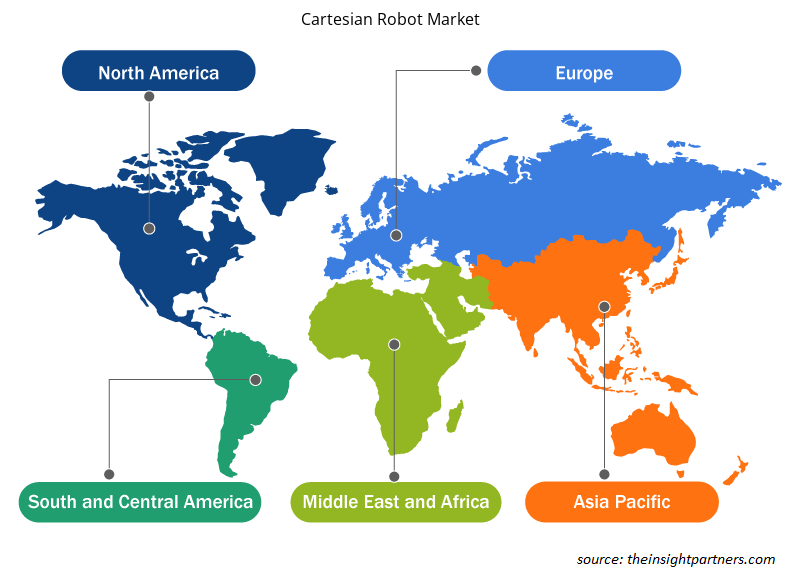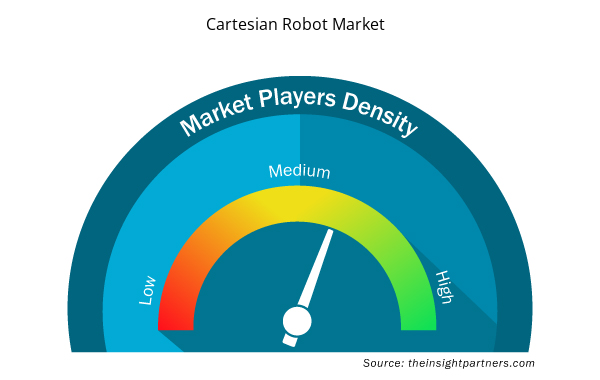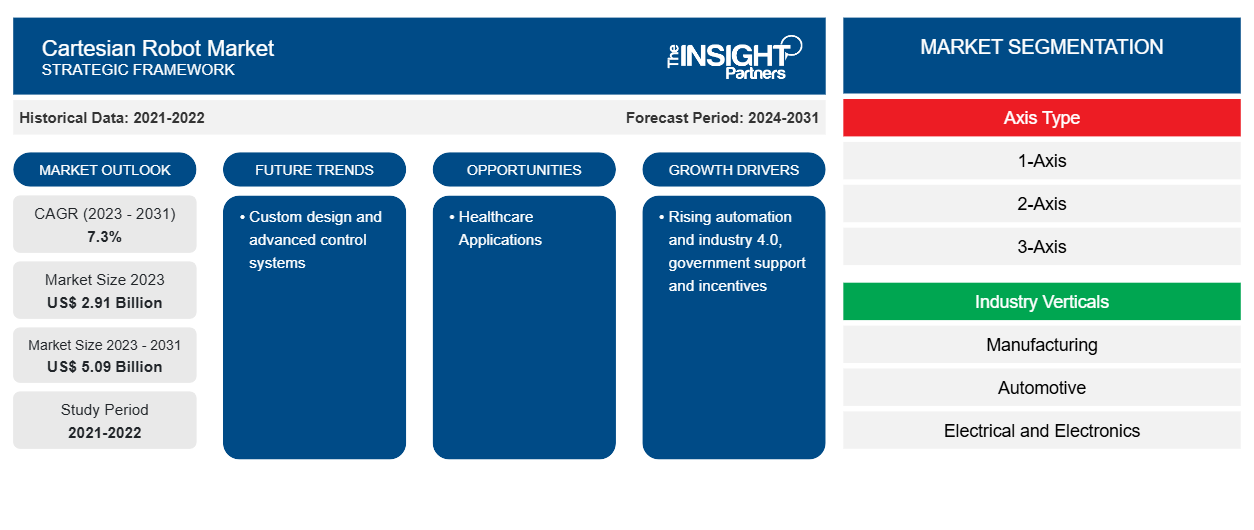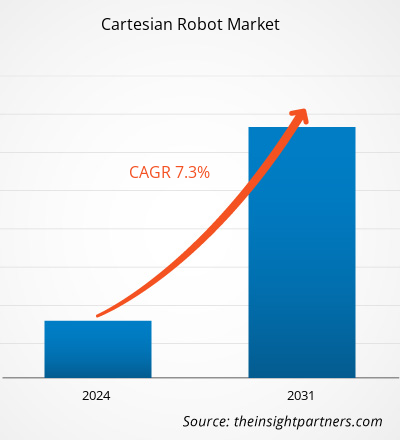من المتوقع أن يصل حجم سوق الروبوتات الديكارتية إلى 5.09 مليار دولار أمريكي بحلول عام 2031 من 2.91 مليار دولار أمريكي في عام 2023. ومن المتوقع أن يسجل السوق معدل نمو سنوي مركب بنسبة 7.3٪ في الفترة 2023-2031. ومن المرجح أن يظل التصميم المخصص وأنظمة التحكم المتقدمة من الاتجاهات الرئيسية في سوق الروبوتات الديكارتية.
تحليل سوق الروبوتات الديكارتية
الروبوتات الديكارتية والروبوتات الخطية وروبوتات الرافعات الجسرية هي كلها مصطلحات للروبوتات الميكاترونية التي تتحرك على طول محاور خطية. تشبه الروبوتات الرافعات الجسرية وتعمل بشكل مشابه. ومع ذلك، يمكن للروبوتات الجسرية القيام بأكثر من مجرد الرفع والتحرك. يمكن أن يكون لها وظائف محددة بناءً على المتطلبات.
نظرة عامة على سوق الروبوتات الديكارتية
الروبوتات الديكارتية هي تقنية روبوتية شائعة وبسيطة يستخدمها المصنعون منذ عقود. تجني الشركات في مختلف القطاعات والتطبيقات فوائد هذه التقنية القابلة للتطوير. الروبوتات الديكارتية هي أكثر منصات الروبوتات تنوعًا المتاحة. يمتد هذا التوسع إلى كل من حجمها المادي المحتمل وقوتها القصوى. يمكن أن تكون الروبوتات الديكارتية صغيرة مثل الطابعات ثلاثية الأبعاد الصغيرة أو ضخمة حسب الرغبة. هناك العديد من الروبوتات الديكارتية الضخمة المتاحة الآن والتي يبلغ طولها 50 مترًا (164 قدمًا) أو أكثر. ويرجع هذا إلى الميكانيكا. تمكن محركات الرف والترس الشركات المصنعة من بناء أنظمة كبيرة للغاية. كما أن ميكانيكيتها هي الأقوى التي ستجدها على منصات الروبوتات الحديثة.
قم بتخصيص هذا التقرير ليناسب متطلباتك
ستحصل على تخصيص لأي تقرير - مجانًا - بما في ذلك أجزاء من هذا التقرير، أو تحليل على مستوى الدولة، وحزمة بيانات Excel، بالإضافة إلى الاستفادة من العروض والخصومات الرائعة للشركات الناشئة والجامعات
- احصل على أهم اتجاهات السوق الرئيسية لهذا التقرير.ستتضمن هذه العينة المجانية تحليلاً للبيانات، بدءًا من اتجاهات السوق وحتى التقديرات والتوقعات.
محركات وفرص سوق الروبوتات الديكارتية
ارتفاع الأتمتة والصناعة 4.0 لصالح السوق
يتغير عالم الأتمتة الصناعية بشكل كبير. وتعد التطورات في التقنيات مثل الذكاء الاصطناعي والروبوتات التعاونية وتكامل إنترنت الأشياء من بين المحركات القليلة التي تدفع هذا النمو. يستخدم عدد لا يحصى من الشركات المصنعة الروبوتات الصناعية لأتمتة الوظائف وتحسين سلامة العمال وتعزيز الناتج الإجمالي للإنتاج مع خفض النفايات ونفقات التشغيل. ومع تزايد شيوع الروبوتات الصناعية في بيئات التصنيع، هناك طلب أكبر على أنواع مختلفة من الروبوتات الصناعية لتناسب تطبيقات وصناعات معينة. على سبيل المثال، وفقًا لتقرير صدر عام 2024، يوجد أكثر من 3.4 مليون روبوت صناعي في العالم الآن. تبلغ نسبة الروبوتات إلى البشر في الأعمال الصناعية 1:71. وتعتزم الشركات الصناعية استثمار 25٪ من رأس مالها في الأتمتة الصناعية على مدى السنوات الخمس المقبلة.IoT integration are among the few drivers driving this growth. Countless manufacturers employ industrial robots to automate jobs, improve worker safety, and boost overall production output while lowering waste and operating expenses. As industrial robots become more common in manufacturing environments, there is a greater demand for various types of industrial robots to suit certain applications and industries. For instance, according to a 2024 report, there are more than 3.4 million industrial robots in the world now. The global robot-to-human ratio in the industrial business is 1:71. Industrial enterprises intend to invest 25% of their capital in industrial automation over the next five years.
تطبيقات الرعاية الصحية – فرصة في الروبوت الديكارتي
تلعب الروبوتات الديكارتية دورًا مهمًا في أتمتة الإجراءات الطبية. في ديسمبر 2020، كان نظام تصوير الأوعية الدموية Allia IGS 7 هو أحدث جيل من نظام تصوير الأوعية الدموية الذي يعمل بالروبوت من GE Healthcare للعلاج الموجه بالصور. تم الكشف عنه خلال الاجتماع الافتراضي لجمعية الأشعة في أمريكا الشمالية (RSNA) لعام 2020. لم يتم تثبيت النظام على الأرض أو السقف بل تم تشغيله على منصة متحركة بعجلات، مما يسمح بإيقافه بعيدًا عن الطريق لتسهيل وصول المريض أو تحويله إلى عمليات مفتوحة. تم توجيه المنصة الآلية بالليزر لضمان تحديد المواقع بدقة في الغرفة والسماح بتقنيات التصوير والتوجيه المتقدمة المتاحة على أنظمة الذراع C الثابتة. إن تطبيق الروبوتات الديكارتية في مثل هذه التطبيقات الطبية الحرجة يخلق فرصًا في السوق.
تقرير تحليل تجزئة سوق الروبوتات الديكارتية
إن القطاعات الرئيسية التي ساهمت في اشتقاق تحليل سوق الروبوت الديكارتي هي نوع المحور والصناعة العمودية.
- بناءً على نوع المحور، ينقسم سوق الروبوتات الديكارتية إلى محور واحد ومحورين وثلاثة محاور وأربعة محاور. احتل قطاع المحاور الثلاثة الحصة الأكبر من السوق في عام 2023.
- استنادًا إلى القطاعات الصناعية، يتم تقسيم سوق الروبوت الديكارتي إلى التصنيع، والسيارات، والكهرباء والإلكترونيات، والأغذية والمشروبات، والمواد الكيميائية والبتروكيماويات، وغيرها.
تحليل حصة سوق الروبوتات الديكارتية حسب المنطقة الجغرافية
ينقسم النطاق الجغرافي لتقرير سوق الروبوت الديكارتي بشكل أساسي إلى خمس مناطق: أمريكا الشمالية، ومنطقة آسيا والمحيط الهادئ، وأوروبا، والشرق الأوسط وأفريقيا، وأمريكا الجنوبية/أمريكا الجنوبية والوسطى.
سيطرت منطقة آسيا والمحيط الهادئ على سوق الروبوتات الديكارتية. إن التصنيع المتزايد في دول مثل الصين والهند واليابان وغيرها من دول آسيا والمحيط الهادئ يدفع الطلب على الروبوتات الديكارتية في المنطقة. يشهد سوق الروبوتات الديكارتية تطوراً كبيراً في أمريكا الشمالية، والذي يمكن أن يعزى إلى الارتفاع الكبير في بعض القطاعات الصناعية مثل السيارات والتصنيع.
رؤى إقليمية حول سوق الروبوتات الديكارتية
لقد قام المحللون في Insight Partners بشرح الاتجاهات والعوامل الإقليمية المؤثرة على سوق الروبوت الديكارتي طوال فترة التنبؤ بشكل شامل. يناقش هذا القسم أيضًا قطاعات سوق الروبوت الديكارتي والجغرافيا في جميع أنحاء أمريكا الشمالية وأوروبا ومنطقة آسيا والمحيط الهادئ والشرق الأوسط وأفريقيا وأمريكا الجنوبية والوسطى.

- احصل على البيانات الإقليمية المحددة لسوق الروبوتات الديكارتية
نطاق تقرير سوق الروبوتات الديكارتية
| سمة التقرير | تفاصيل |
|---|---|
| حجم السوق في عام 2023 | 2.91 مليار دولار أمريكي |
| حجم السوق بحلول عام 2031 | 5.09 مليار دولار أمريكي |
| معدل النمو السنوي المركب العالمي (2023 - 2031) | 7.3% |
| البيانات التاريخية | 2021-2022 |
| فترة التنبؤ | 2024-2031 |
| القطاعات المغطاة | حسب نوع المحور
|
| المناطق والدول المغطاة | أمريكا الشمالية
|
| قادة السوق وملفات تعريف الشركات الرئيسية |
|
كثافة اللاعبين في السوق: فهم تأثيرها على ديناميكيات الأعمال
يشهد سوق الروبوتات الديكارتية نموًا سريعًا، مدفوعًا بالطلب المتزايد من المستخدم النهائي بسبب عوامل مثل تفضيلات المستهلك المتطورة والتقدم التكنولوجي والوعي المتزايد بفوائد المنتج. ومع ارتفاع الطلب، تعمل الشركات على توسيع عروضها والابتكار لتلبية احتياجات المستهلكين والاستفادة من الاتجاهات الناشئة، مما يؤدي إلى زيادة نمو السوق.
تشير كثافة اللاعبين في السوق إلى توزيع الشركات أو المؤسسات العاملة في سوق أو صناعة معينة. وهي تشير إلى عدد المنافسين (اللاعبين في السوق) الموجودين في مساحة سوق معينة نسبة إلى حجمها أو قيمتها السوقية الإجمالية.
الشركات الرئيسية العاملة في سوق الروبوت الديكارتي هي:
- أي بي بي
- شركة دينسو ويف
- مجموعة ميديا.
- شركة سيكو إبسون.
- شركة شيباورا للماكينات المحدودة
- شركة ياماها موتور المحدودة
إخلاء المسؤولية : الشركات المذكورة أعلاه ليست مرتبة بأي ترتيب معين.

- احصل على نظرة عامة على أهم اللاعبين الرئيسيين في سوق الروبوتات الديكارتية
أخبار سوق الروبوتات الديكارتية والتطورات الأخيرة
يتم تقييم سوق الروبوت الديكارتي من خلال جمع البيانات النوعية والكمية بعد البحث الأولي والثانوي، والذي يتضمن منشورات الشركات المهمة وبيانات الجمعيات وقواعد البيانات. فيما يلي قائمة بالتطورات في سوق الروبوت الديكارتي والاستراتيجيات:
- كشفت شركة KUKA Robotics عن نظام تشغيل جديد لأذرع الروبوتات التعاونية والصناعية في معرض هانوفر 2021. يهدف نظام التشغيل الجديد KUKA iiQKA.OS إلى أن يكون "سهل الاستخدام مثل الهاتف المحمول". الغرض الأساسي من تصميم نظام التشغيل الجديد هو جعله بسيطًا بما يكفي ليتمكن المشغلون الجدد من استخدامه دون الحاجة إلى تدريب متخصص. هذا هدف مهم لتصميم البرامج، خاصة في سياق الروبوتات التعاونية. (المصدر: KUKA AG، بيان صحفي، 2021)
تقرير سوق الروبوتات الديكارتية والتغطية والمخرجات
يوفر تقرير "حجم سوق الروبوت الديكارتي والتوقعات (2023-2031)" تحليلاً مفصلاً للسوق يغطي المجالات التالية:
- حجم السوق والتوقعات على المستويات العالمية والإقليمية والوطنية لجميع قطاعات السوق الرئيسية التي يغطيها النطاق
- ديناميكيات السوق مثل المحركات والقيود والفرص الرئيسية
- الاتجاهات المستقبلية الرئيسية
- تحليل مفصل لقوى PEST/Porter الخمس وSWOT
- تحليل السوق العالمي والإقليمي الذي يغطي اتجاهات السوق الرئيسية واللاعبين الرئيسيين واللوائح والتطورات الأخيرة في السوق
- تحليل المشهد الصناعي والمنافسة الذي يغطي تركيز السوق، وتحليل خريطة الحرارة، واللاعبين البارزين، والتطورات الأخيرة
- ملفات تعريف الشركة التفصيلية
- التحليل التاريخي (سنتان)، السنة الأساسية، التوقعات (7 سنوات) مع معدل النمو السنوي المركب
- تحليل PEST و SWOT
- حجم السوق والقيمة / الحجم - عالميًا وإقليميًا وقطريًا
- الصناعة والمنافسة
- مجموعة بيانات Excel



Report Coverage
Revenue forecast, Company Analysis, Industry landscape, Growth factors, and Trends

Segment Covered
This text is related
to segments covered.

Regional Scope
North America, Europe, Asia Pacific, Middle East & Africa, South & Central America

Country Scope
This text is related
to country scope.
الأسئلة الشائعة
The global Cartesian Robot market was estimated to be US$ 2.9 billion in 2023 and is expected to grow at a CAGR of 7.3% during the forecast period 2023 - 2031.
Rising automation and Industry 4.0 are the major factors that propel the global Cartesian Robot market growth.
In terms of revenue, the 3-axis segment held the major market share in 2023.
The key players holding majority shares in the global cartesian robot market are ABB, Denso Wave Incorporated, Midea Group, and Seiko Epson Corporation.
Custom design and advanced control systems are anticipated to bring new cartesian robot market trends in the coming years.
Trends and growth analysis reports related to Electronics and Semiconductor : READ MORE..
The Insight Partners performs research in 4 major stages: Data Collection & Secondary Research, Primary Research, Data Analysis and Data Triangulation & Final Review.
- Data Collection and Secondary Research:
As a market research and consulting firm operating from a decade, we have published and advised several client across the globe. First step for any study will start with an assessment of currently available data and insights from existing reports. Further, historical and current market information is collected from Investor Presentations, Annual Reports, SEC Filings, etc., and other information related to company’s performance and market positioning are gathered from Paid Databases (Factiva, Hoovers, and Reuters) and various other publications available in public domain.
Several associations trade associates, technical forums, institutes, societies and organization are accessed to gain technical as well as market related insights through their publications such as research papers, blogs and press releases related to the studies are referred to get cues about the market. Further, white papers, journals, magazines, and other news articles published in last 3 years are scrutinized and analyzed to understand the current market trends.
- Primary Research:
The primarily interview analysis comprise of data obtained from industry participants interview and answers to survey questions gathered by in-house primary team.
For primary research, interviews are conducted with industry experts/CEOs/Marketing Managers/VPs/Subject Matter Experts from both demand and supply side to get a 360-degree view of the market. The primary team conducts several interviews based on the complexity of the markets to understand the various market trends and dynamics which makes research more credible and precise.
A typical research interview fulfils the following functions:
- Provides first-hand information on the market size, market trends, growth trends, competitive landscape, and outlook
- Validates and strengthens in-house secondary research findings
- Develops the analysis team’s expertise and market understanding
Primary research involves email interactions and telephone interviews for each market, category, segment, and sub-segment across geographies. The participants who typically take part in such a process include, but are not limited to:
- Industry participants: VPs, business development managers, market intelligence managers and national sales managers
- Outside experts: Valuation experts, research analysts and key opinion leaders specializing in the electronics and semiconductor industry.
Below is the breakup of our primary respondents by company, designation, and region:

Once we receive the confirmation from primary research sources or primary respondents, we finalize the base year market estimation and forecast the data as per the macroeconomic and microeconomic factors assessed during data collection.
- Data Analysis:
Once data is validated through both secondary as well as primary respondents, we finalize the market estimations by hypothesis formulation and factor analysis at regional and country level.
- Macro-Economic Factor Analysis:
We analyse macroeconomic indicators such the gross domestic product (GDP), increase in the demand for goods and services across industries, technological advancement, regional economic growth, governmental policies, the influence of COVID-19, PEST analysis, and other aspects. This analysis aids in setting benchmarks for various nations/regions and approximating market splits. Additionally, the general trend of the aforementioned components aid in determining the market's development possibilities.
- Country Level Data:
Various factors that are especially aligned to the country are taken into account to determine the market size for a certain area and country, including the presence of vendors, such as headquarters and offices, the country's GDP, demand patterns, and industry growth. To comprehend the market dynamics for the nation, a number of growth variables, inhibitors, application areas, and current market trends are researched. The aforementioned elements aid in determining the country's overall market's growth potential.
- Company Profile:
The “Table of Contents” is formulated by listing and analyzing more than 25 - 30 companies operating in the market ecosystem across geographies. However, we profile only 10 companies as a standard practice in our syndicate reports. These 10 companies comprise leading, emerging, and regional players. Nonetheless, our analysis is not restricted to the 10 listed companies, we also analyze other companies present in the market to develop a holistic view and understand the prevailing trends. The “Company Profiles” section in the report covers key facts, business description, products & services, financial information, SWOT analysis, and key developments. The financial information presented is extracted from the annual reports and official documents of the publicly listed companies. Upon collecting the information for the sections of respective companies, we verify them via various primary sources and then compile the data in respective company profiles. The company level information helps us in deriving the base number as well as in forecasting the market size.
- Developing Base Number:
Aggregation of sales statistics (2020-2022) and macro-economic factor, and other secondary and primary research insights are utilized to arrive at base number and related market shares for 2022. The data gaps are identified in this step and relevant market data is analyzed, collected from paid primary interviews or databases. On finalizing the base year market size, forecasts are developed on the basis of macro-economic, industry and market growth factors and company level analysis.
- Data Triangulation and Final Review:
The market findings and base year market size calculations are validated from supply as well as demand side. Demand side validations are based on macro-economic factor analysis and benchmarks for respective regions and countries. In case of supply side validations, revenues of major companies are estimated (in case not available) based on industry benchmark, approximate number of employees, product portfolio, and primary interviews revenues are gathered. Further revenue from target product/service segment is assessed to avoid overshooting of market statistics. In case of heavy deviations between supply and demand side values, all thes steps are repeated to achieve synchronization.
We follow an iterative model, wherein we share our research findings with Subject Matter Experts (SME’s) and Key Opinion Leaders (KOLs) until consensus view of the market is not formulated – this model negates any drastic deviation in the opinions of experts. Only validated and universally acceptable research findings are quoted in our reports.
We have important check points that we use to validate our research findings – which we call – data triangulation, where we validate the information, we generate from secondary sources with primary interviews and then we re-validate with our internal data bases and Subject matter experts. This comprehensive model enables us to deliver high quality, reliable data in shortest possible time.


 احصل على عينة مجانية لهذا التقرير
احصل على عينة مجانية لهذا التقرير